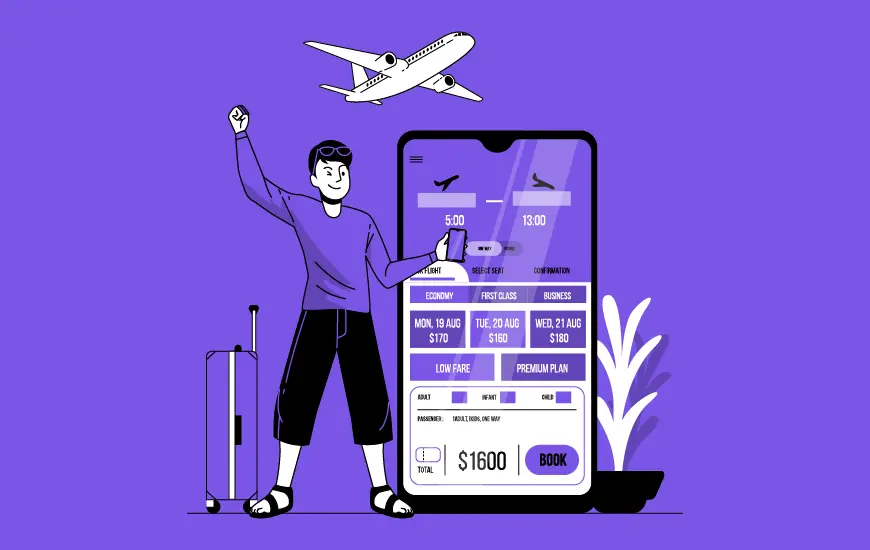- What Is The On Demand Charter Flights Economy About?
- The Key Stakeholders of the On Demand Air Travel Sector
- Pilots
- Customers
- eVTOL companies
- Airports
- FBOs
- What Makes On Demand Air Transportation Service a Revolutionary Business Idea?
- Critical Challenges Standing Infront of On Demand Aviation Sector
- Regulations
- Air traffic management system
- Infrastructure
- Cost economics
- Hardware challenges in eVTOL
- Pilots’ availability
- What Can Businesses Do to Become an Early Participant of the Revolution?
The onset of the sharing economy began around the time of the Great Recession, and now in the present time has expanded itself to become one of the most recession-proof business models. DoorDash, Couchsurfing, Uber, and Upwork are some key success stories of sharing marketplaces that are operating in the sharing economy.
The next area in which the on-demand economy is all set to enter is one whose transformation no one would have bet on till a few years back – the aviation industry.
Here’s everything you should know about the on demand aircraft – an experimentative sector which is all set to boom in the time to come.
- What Is The On Demand Charter Flights Economy About?
- The Key Stakeholders of the On Demand Air Travel Sector
- What Makes On Demand Air Transportation Service a Revolutionary Business Idea?
- Critical Challenges Standing Infront of On Demand Aviation Sector
- What Can Businesses Do to Become an Early Participant of the Revolution?
What Is The On Demand Charter Flights Economy About?

Imagine booking an Uber to cover several miles-long distances. Now factor in the congestion on the road, surge pricing, and uncertainty of arrival time. On demand urban air transportation is the answer to these issues.
Working on the same model as Uber, brands have started entering the business of order on demand flights – something that can be defined as business like Uber for aeroplanes. The concept, while explored by a number of charter flight companies, got its share of attention when Uber announced Uber Elevate.

Uber Elevate is a term that the mobility giant has coined for its UberAir, an aerial electric ride-sharing service in addition to other services like food delivery, etc. which can benefit from the air transport model.
The Key Stakeholders of the On Demand Air Travel Sector
Pilots
Generally, it is the pilots who pass the information on seat vacancy in the on demand flight application. The customers then book a seat basis that information.
Customers
They are the main revenue-maker participant of the application. The inception of on demand for air travel is an event that would directly impact the users looking for luxurious travel on a limited budget.
eVTOL companies
These are the vehicles that would take people from point A to point B through an aerial route. These battery-operated automatic models are architecturally different from helicopters and other private aircraft. They fly at a speed of 60 mph and are designed to be a lot less noisy.

Although not a must-have for entering the domain (since businesses always have the option to partner with private jet providers), on demand VTOL service is poised to become a key player in the segment.
[Also Read: How does the Departure Control System help airline operations?]
Airports
Businesses looking to enter the aircraft on demand space will have to partner with airports – commercial and private – to expand their reach among the customers. For brands that aim to partner with eVTOL aircraft providers, it will be important to look into airports that have charging points.
FBOs
Fixed Base Operators will play the same crucial role in the on demand urban transit sector as they do in the scheduled private aviation sector. Providing the same USPs as the traditional private aviation sector will be the main selling point of the on demand aircraft – something that is only possible with FBO’s help.
What Makes On Demand Air Transportation Service a Revolutionary Business Idea?
Besides the lucrative image of flying private, on demand urban air mobility sector gives the customers a series of advantages (ones which are aligned with the USPs on demand app development services) – they can board the flight directly, standing in the long check-in lines for scheduled flights is no longer a necessity. Pilots, on the other hand, are able to divide the operating expense of the flight (oil, fuel, rental fees, or airport expenditures) while being able to keep their license – an event which depends on them amassing a minimum number of flying hours, take-offs, and landings in a year.
The model in itself solves the biggest expense of the private aviation sector – operation and maintenance expenses.
There are a strong pro pilot and customer nature of the on-demand mobility model which comes back with an added benefit of the favorable regulations of the aviation sector across the globe [UK’s Civil Aviation Authority (CAA) underpins the following boundaries for flight-sharing: non-commercial aircraft must transport a maximum of six passengers; only the direct flying costs (airfield charges, fuel, and rental fee) should be split; and there must be no profit element on either side)].
To summarize it, what makes the sector truly profitable in nature is a combination of the following –
- On demand aviation gives private flying access to a whole batch of an audience who are interested in a travel experience upgrade
- An added benefit of no TSA screening lines, private concierge service, custom food options, minute-long bag retrieval process, and a door to destination travel ETA being cut down by several hours.
Although a futuristic business model, urban air transportation system’s present-day success can be validated by the fact that Wingly, a flight-sharing platform which presently operates in France, England, and Germany with more than 150,000 users and 60,000 flights announced a €2m fundraise.
The path on which on demand aviation is, it’s adorned with growth. But what cannot be ignored are some inherent challenges that stand in front of it.
Critical Challenges Standing Infront of On Demand Aviation Sector

Regulations
Although the European aviation market has been open to welcoming on demand aircraft, other nations are still playing safe. An example of this is the US FAA board decision to support trials only in the remote areas and not in the dense areas.
Air traffic management system
Presently, a majority of the air traffic is monitored by human controllers who interact directly with the pilots. This approach is barely sustainable for current traffic. To effectively manage the demand, digital systems will have to be set up for monitoring the aircraft in the skies. These systems could bring scalability into air traffic management through the mode of automated monitoring and management of the increased activity. One of the working examples of a digital traffic management system can be seen in Airbus’s Unmanned Traffic Management system.
Infrastructure
While the present infrastructure might be able to support the initial trials, it is unlikely that they’ll be able to accommodate new businesses at scale. A solution to this could be the creation of take-off and landing areas by sharing the existing helipads – In the USA there are 5,664 helipads of which 66 are used for private use. But for a major portion of the day, they stand unused.
While this can be a placeholder solution, the industry would need to find out other solutions soon too.
Cost economics
For the business model to gain stickiness, it will have to have a price range that the masses are comfortable with. Achieving this while keeping the maintenance and operational costs into consideration will call for a sound on demand app development company helping you draft your business model.
[Also Read: How much does it cost to develop a fleet management software]
Hardware challenges in eVTOL
There are two major challenges that we can foresee for the on demand private aviation industry when it’d reach mass adoption – Noise and Battery efficiency. But by the time we reach the stage where eVTOLS become a norm, we will surely see industry players coming in with solutions.
Pilots’ availability
Until eVTOL becomes globally accepted, pilots will continue to be a scarce resource in the economy. This will call for measures like the need for a much easier pilot certification program, creation of aircraft that would work with minimally trained pilots.
What Can Businesses Do to Become an Early Participant of the Revolution?
To become a part of the trend with a promising future, businesses will need to partner with on demand app development solution providers who understand the veins of the aviation industry.
To get a heads up, research about the market – the user base, probable growth, active competitors, failed businesses in the sector etc. Once you have gathered your research data, the next step should be to convert them into visuals. You can start with mood boards, user flow diagrams, and other similar visual illustrations to understand why a user would move from a commercial flying to a flight-sharing one.
Ultimately, we would advise entrepreneurs to deep dive and learn from the businesses which are entering the segment – the kind of partnerships they are making, areas they are targeting, investors they are able to attract and how they are leveraging data analytics in the airline industry.
If it appears too much to manage single-handedly, let us help you. Contact us.


- In just 2 mins you will get a response
- Your idea is 100% protected by our Non Disclosure Agreement.

How Airlines Use Data Analytics for Enhanced Operational Efficiency - 10 Use Cases and Benefits
In today’s competitive airline industry, leveraging data analytics is not just an advantage but a necessity. Airlines face numerous challenges including fluctuating fuel costs, stringent regulatory requirements, and high customer expectations, all of which demand smarter, data-driven decision-making to enhance operational efficiencies and maintain profitability. Data analytics offers powerful solutions by enabling airlines to process…

How Digital Twin Technology is Transforming Airline Operations and Safety
The aviation industry, like other sectors, plays a significant role in the economy of every country. Unfortunately, recent years have posed immense challenges for this industry, particularly in 2020 and 2021 during the COVID-19 crisis. Undoubtedly, the airline segment experienced a drastic downturn and incurred an enormous loss of $168 billion. The aviation sector addressed…

Flight Booking App Development Cost: Everything You Need to Know
As per recent reports, there are approximately 6.6 billion active smartphone users globally, making mobile apps ubiquitous in today's digital ecosystem. The exceptional revenue generated by these mobile apps has made them an important aspect of modern business. Interestingly, flight booking apps are also gaining instant popularity in the travel and tourism industry, whose market…















